What you need
3 oz of cocoa butter
6 oz of shea butter
Essential oil or fragrance
(optional)
Instructions
Ø
Melt grated cocoa and shea butter gently in double
boiler of microwave oven until they have fully liquefied (melted).
Ø
Add your preferred liquid oil, (if using virgin coconut oil, melt it first) and whisk the
mixture with a hand blender then cool it gently for 5 minutes in the fridge or
in a bowl of ice. Take care not to cool
it too fast as it can get grainy or lumpy.
Ø
Add a few drops of your preferred essential oil
or fragrance at this point (3-5 drops) and give it another whisk to get air
into it.
Ø
Cool your mixture some more 5 minutes and whisk
it again. Repeat the process till you are happy with its consistency. Leave it to set before use.
The Cocoa butter helps relieve dry
skin, dermatitis and eczema. It is effective in reducing and prevention of
stretch marks and scars. The Shea butter leaves your skin feeling really soft
and smooth. It is great for dry skin and softens rough areas of the skin. It is
non-greasy and is quickly absorbs into the skin. Coconut oil is especially good for dry skin
as it is an excellent skin moisturizer and softener. Argan oil is great at
counteracting the effects of age and weather.
Tips
- If you find the body butter cream hard and you prefer it softer next time,
formulate the mixture using a higher percentage of liquid oil. For a
harder cream, use a higher percentage of cocoa butter.
- As with any 'at home remedy', first test for sensitivity; especially to essential oils, on a small
patch of skin before use.
- Care should be taken when using essential oils.
